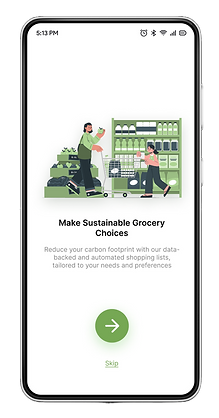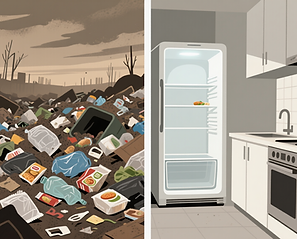BuySmart
I care about the environment, and solving for problems using design brings me joy. In simple terms BuySmart is an app that helps you reduce food waste and saves you money, this is the core value of the app.




The Problem
Food waste is a massive environmental crisis, and it starts in our shopping carts.
In the United States, households waste approximately 76 billion pounds of food annually - equivalent to 1,000 Empire State Buildings. This waste contributes to:
-
21% of landfill volume (generating harmful methane gas)
-
$1,500 per household in wasted money annually
-
Massive carbon footprint from production, transportation, and disposal

The Root Cause
Through our research, we discovered that food waste begins with poor shopping decisions driven by :
-
Disconnected shopping - People buy groceries without knowing what they already have at home
-
Impulse purchases - Exciting new products end up unused while staples expire
-
Poor meal planning - Ingredients are bought without a clear plan for how to use them
The Opportunity
What if we could make sustainable shopping as easy and engaging as scrolling through social media?
Our challenge was to design a solution that would help environmentally-conscious consumers make better purchasing decisions while reducing the cognitive load of meal planning and inventory management.
User Research & Insights
Research Methodology
Given our one-month timeline, we implemented a focused research approach designed to maximize insights while maintaining rigor
-
12 in-depth user interviews (6 frequent grocery shoppers, 6 occasional shoppers)
-
Survey of 85 participants regarding shopping habits and food waste patterns
-
Observational studies conducted at 3 local grocery stores
-
Week-long digital diary study with 8 participants tracking food waste behaviors
Key Research Findings
Primary Insight: Consumers demonstrate strong intentions toward sustainable practices, but existing systems prioritize convenience and impulse purchasing over thoughtful consumption.
Critical Discoveries :
-
73% of participants purchased groceries without first assessing existing inventory
-
Average consumer makes 2.3 unplanned purchases per shopping trip
-
Meal planning frequency decreased significantly during periods of high stress or busy schedules
-
Food expiration emerged as the primary driver of waste, yet consumers rarely checked expiration dates during shopping
User Personas

Primary Persona: The Health-Conscious Professional
Sarah, 35 | Software Engineer | Chicago | $100K+ income
"I want to be more aware of food expiration and actively try to prevent food waste in our home, but it's challenging with my schedule."
Sarah represents busy professionals who prioritize health and sustainability but struggle with execution due to time constraints. She values nutritious eating and environmental responsibility but often finds herself overwhelmed by the cognitive load of meal planning and inventory management.
Goals:
-
Maintain organized meal planning and efficient grocery shopping
-
Consume nutritious food consistently
-
Minimize food waste and environmental impact
-
Reduce time spent on food-related decision making
Pain Points:
-
Shopping without awareness of existing inventory
-
Fresh ingredients expiring due to forgotten purchases
-
Difficulty maintaining meal plans during high-stress periods
-
Lack of real-time access to expiration date information while shopping
Secondary Persona: The Enthusiastic Explorer
Alex, 24 | Entry-level Employee | $40K-50K income
"Whenever I go shopping, I end up overpurchasing, even though I need to stay on budget."
Alex represents younger consumers who are passionate about food discovery and culinary exploration, particularly influenced by social media content. However, this enthusiasm often leads to impulsive purchasing decisions that exceed budget constraints and result in ingredient waste.
Goals:
-
Explore new recipes and culinary experiences
-
Maintain adherence to budget constraints
-
Make intentional purchasing decisions
-
Maximize utilization of purchased ingredients
Pain Points:
-
Limited awareness of existing grocery inventory
-
Susceptibility to impulse purchases influenced by social media
-
Purchasing ingredients without clear utilization plans
-
Decision paralysis leading to food waste and budget overruns

Design Process & Ideation
From Insights to Solutions
With clear user pain points identified, we needed to translate research findings into actionable design opportunities. Our approach focused on reducing cognitive load while making sustainable shopping behaviors feel natural and engaging.


Key Feature Ideation
Problem: Users shop without knowing what they already have at home
Solution: Gamified Inventory Management
We designed a Tinder-style swipe interaction for quickly updating pantry inventory. Users can swipe left on items they already have (like carrots in the fridge) and swipe right on items they need (like tomatoes for the shopping list). This familiar gesture makes inventory management feel effortless rather than tedious.




Problem: Receipt entry is cumbersome and time-consuming
Solution: Smart Receipt Scanning
Users can photograph their grocery receipts, and our ML integration automatically updates their pantry inventory. This eliminates the friction of manual entry while ensuring inventory stays current.
Problem: Meal planning feels overwhelming and disconnected from available ingredients
Solution: Inventory-Based Recipe Suggestions
The app suggests recipes based on ingredients users already have, reducing waste while simplifying meal planning decisions.


User Flow Architecture

This user flow diagram illustrates a comprehensive journey for what appears to be a meal planning and grocery shopping application. Here's the detailed flow:
Main User Journey (Orange/Red Path)
The flow begins at the Tutorial screen, which branches into two initial paths:
-
Login/Sign Up → leads to Profile
-
Create Household (optional) → also connects to Profile
A persistent navigation bar provides access to four main sections:
-
Shopping List (Yellow)
-
Inventory (Green)
-
Recipe (Purple)
-
Meal Planner (Blue)
Feature Branches
Shopping List Flow (Yellow)
-
Displays Input Methods options
-
Users can Enter Items manually
-
A decision point asks "Use Shopping mode?"
-
If Yes → Shopping Mode → Finish Shopping? → Add Extra Items if bought → Items added to Inventory
-
If No → Returns to Shopping List
-
Inventory Management (Green)
Two input method entry points lead to:
-
A decision diamond "Add Existing Items to Inventory"
-
If Yes → Recipe Interaction
-
If No → Items Added to Inventory
-
Recipe Section (Purple)
-
Recipe Based on Inventory → Choose Recipe → Start Cooking
Meal Planning (Blue)
-
Enter Dietary Preferences → Enter Days → Meal Plan Created → Recipe Based on Inventory → Start Cooking
Information Architecture Decisions
Green Color Psychology: We selected a green-based color scheme to psychologically reinforce environmental consciousness and healthy eating associations, while ensuring accessibility standards for contrast ratios.

Tab-Based Navigation: Research showed users needed quick access to four core functions: Shopping List, Inventory, Recipe Suggestions, and Meal Planning. The bottom tab structure provides immediate access while maintaining spatial consistency.

Progressive Disclosure: Complex features like detailed nutrition information or environmental impact scores are available but not prominently displayed, preventing cognitive overload for casual users while satisfying power users.



Impact & Reflection


Projected Success Metrics
-
Reduce household food waste by 30% within 3 months of use
-
Increase shopping list adherence from 60% to 85%
-
Improve meal planning frequency from 1-2 times/week to 4-5 times/week
-
User engagement with sustainability features >70%
